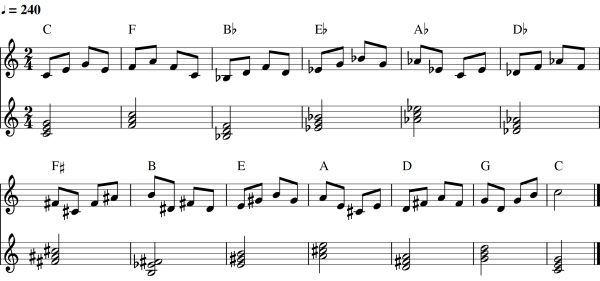Audio: circle of fifths (0:07)

| CIRCLE OF FIFTHS |
|---|
| (F#)Gb Db Ab Eb Bb F C G D A E B F#(Gb) |
circle of fifths plays a modulating melody on a banjo and a harmony on a steel guitar at a breathless tempo of 240bpm. The circle of fifths figure shows the score and the table lists the notes in a circle of fifths. The score may look complex but it is straightforward to write:
A circle of fifths is a sequence of perfect fifths.
The perfect fifth and the perfect fourth are the closest related intervals after unison and octave. This relationship goes back to Pythagorean tuning and the other tuning systems of just intonation and equal temperament. These tuning systems all use successive intervals of a perfect fifth to derive the 12 notes used in the modern-day chromatic scale. The circle of fifths shows how these twelve notes relate to each other.
The circle of fifths is continuous. Start at any position in the circle and proceed clockwise up in perfect fifths. Proceed anticlockwise down in perfect fifths. Twelve modulations through the circle brings you back to the start.
The notes at either end of the circle of fifths table are enharmonic. This means the notes, F# and Gb, have the same pitch but are spelled differently. When you reach one end of the circle you start again at the other end and continue travelling in the same direction.
The circle of fifths provides a route map for modulation: